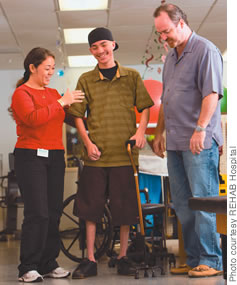REHAB Celebrates 55 Years
Interviewed by Melissa Moniz
Wednesday - August 27, 2008
E-mail this story | Print this page | Comments (0) | Archive
 Del.icio.us Share
Del.icio.us Share

Dr. Gary Okamoto
Chief Medical Executive, Rehabilitation Hospital of the Pacific; Associate Clinical Professor, John A. Burns School of Medicine
Where did you receive your schooling and training?
I attended Roosevelt High School and earned a B.A. in political science at the University of Hawaii. I graduated from the Washington University School of Medicine in Saint Louis, and completed my physiatry residency and two-year research fellowship at the University of Washington, Seattle. I was on the academic faculty there until returning to the Islands 25 years ago.
Can you describe what a typical workday is like for you?
There are three parts to my “typical” workday. First, I do patient rounds on the inpatient units, interacting with nurses, therapists, psychologists, case managers or consulting internists. Whether I have one patient or 10 patients, I’ll make rounds seven days a week. Once a week, my colleagues and I hold team conferences, reviewing clinical data and adjusting our clinical goals based on the patient’s plan to return home. Second, administrative activity consumes a lot of time, as I work with other individuals developing clinical programs, addressing quality-of-care issues and collaborating with the physiatrists and internists. Third, physician community relations involves time away from the campus, educating practitioners and hospital leaders about REHAB and, importantly, eliciting feedback from them about what their needs are to help patients with disabilities. Visiting our staff at REHAB’s outpatient comprehensive rehabilitation clinics also enables me to understand how we can serve the practicing physicians well.
What is most challenging about what you do?
For my colleagues and me, the most challenging task is fulfilling REHAB’s mission to “rebuild lives together” by making available the best care to patients locally. Every patient is uniquely different and we have to share common goals, show improvement in patient functions, train caregivers, keep within a reasonable time frame and discharge the patient safely home. This process requires a patient-centered philosophy, technical competence and plenty of teamwork.

|
Is REHAB planning any special events to celebrate its 55th anniversary?
The most auspicious events are, hopefully, receiving official proclamations by Governor Lingle and Mayor Hannemann celebrating REHAB’s role in affording local people access to inpatient rehabilitation. We are also planning an employee recognition luncheon to thank all staff members for their dedication to our mission of rebuilding lives together.
What role does rehabilitation play in health care?
Medical rehabilitation is the only field that devotes itself entirely to the restoration of patient’s physical and cognitive function - mobility, self-care, swallowing, communication, problem solving, coping - for the purpose of being self-reliant. Inpatient rehabilitation has been health care’s answer to returning patients to the community versus institutionalizing them in long-term nursing homes. Eighty-seven percent of patients leaving REHAB return to a home environment, 10 percent more than the national average. Medical rehabilitation is based, in part, on educating and training patients to prevent complications such as infections,wounds, pain, depression, incontinence and aspiration pneumonia.
Is REHAB Hospital the only facility of its kind in Hawaii?
Yes, REHAB is the only hospital in Hawaii with licensed and certified beds for medical rehabilitation. Although nursing homes, clinics and home-care agencies have rehabilitation services, none offers the intensity of treatment and the wide range of professional expertise. Medicare, Medicaid, HMSA, Kaiser and other health plans have benefit coverage for REHAB’s inpatient care.
What types of conditions are usually treated at REHAB?
We admit patients disabled by stroke, traumatic brain injury, spinal cord trauma, complex orthopedic conditions, cardiopulmonary debility, limb amputation and complicated fractures. Patients are hospitalized for two to four weeks, sometimes less and sometime more, depending on multiple factors like medical condition, functional goals, rate of recovery, health plan benefits and care-givers.
How does a patient come to REHAB?
At the acute care hospital, the patient’s attending physician, surgeon, case manager, social worker or nurse recommends REHAB to their patient. In turn, REHAB’s referral admission coordinators are notified and proceed to determine if the patient would benefit from inpatient rehabilitation or, possibly, other rehabilitation services through skilled nursing facilities, home-care agencies or one of our seven outpatient clinics.
Do you foresee future trends in rehabilitation services?
Yes. Patients will be older, sicker and more medically complex coming from acute care hospitals to REHAB, resulting in a greater need for more specialists and technology. Patients at risk will have three or more chronic conditions that require multiple medications, monitoring tests and medical specialists. Other trends will be treatment mediated via the Internet, wider availability of adaptive equipment and supplies, technologically “smart” homes, rehabilitation-trained corps of professional care-givers, sophisticated health plans that pay for the preventive aspects of medical rehabilitation, better pharmaceuticals for the brain and spinal cord injured or diseased, and efficient patient-physician-hospital connectivity via personal electronic health records and electronic medical records. Hopefully, the incidence of serious disabilities will diminish with less invasive surgery, genetically engineered pharmaceuticals and public health strategies. Prevention is medical rehabilitation’s best cure for disability.
E-mail this story | Print this page | Comments (0) | Archive
Most Recent Comment(s):













